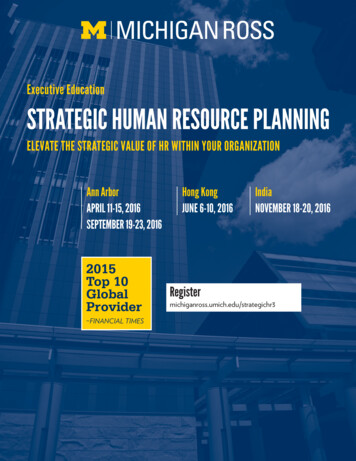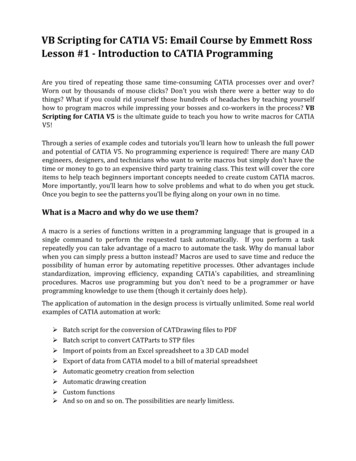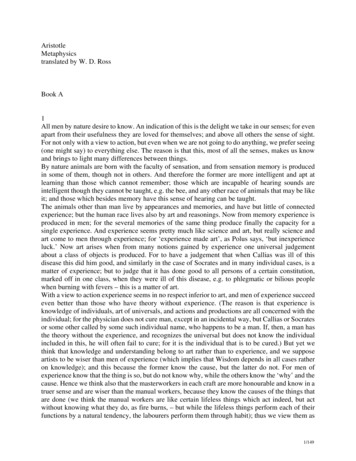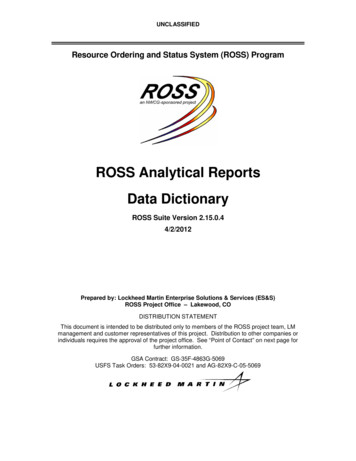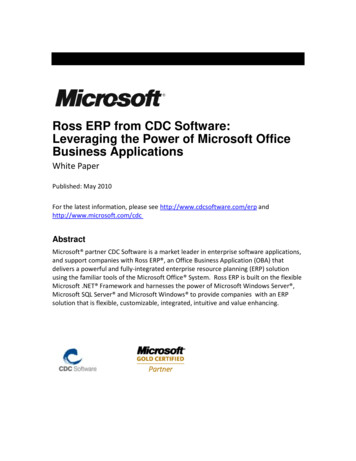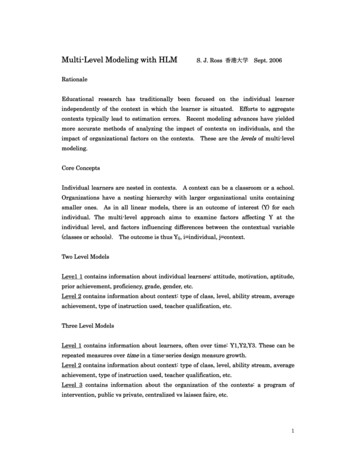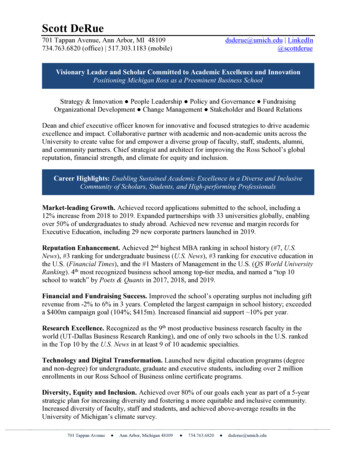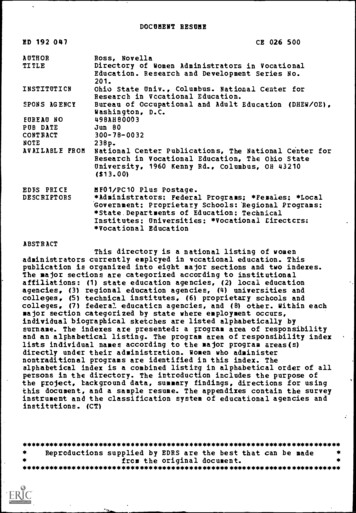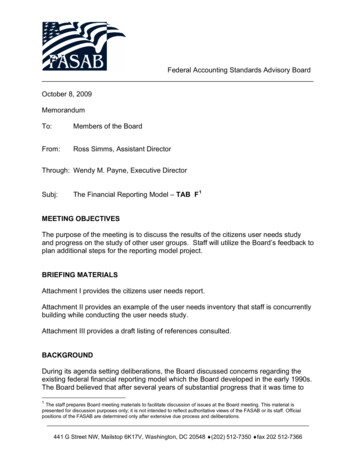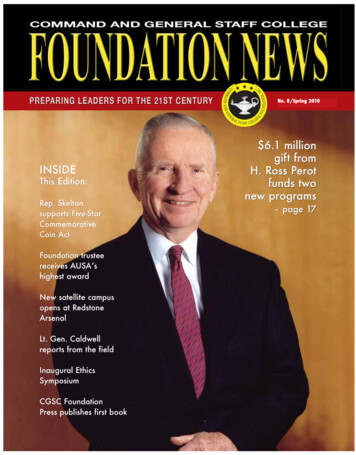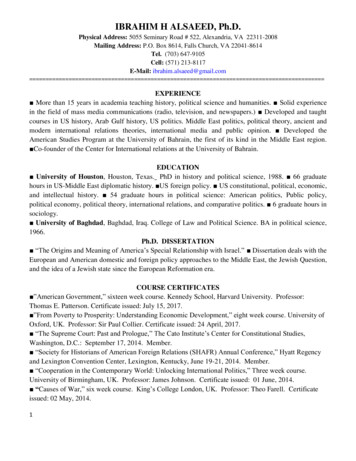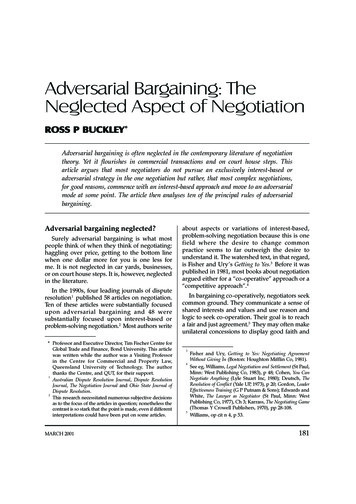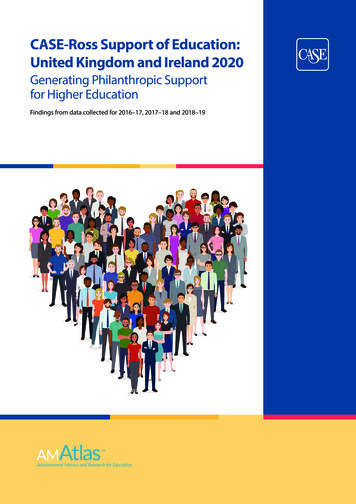
Transcription
CASE-Ross Support of Education:United Kingdom and Ireland 2020Generating Philanthropic Supportfor Higher EducationFindings from data collected for 2016–17, 2017–18 and 2018–19
2020 Council for Advancement and Support of EducationOriginal publication date: 13 May 2020All rights reserved. No part of the material protected by this copyright may be reproduced or used in anyform, electronic or mechanical, including photocopying, recording, or by any information storage andretrieval system, without written permission from the Council for Advancement and Support of Education.Limit of Liability/Disclaimer: While the publisher has used its best efforts in preparing this document, itmakes no representations or warranties in respect to the accuracy or completeness of its contents. Noliability or responsibility of any kind (to extent permitted by law), including responsibility for negligence isaccepted by the Council for Advancement and Support of Education, its servants, or agents. All informationgathered is believed correct at publication date. Neither the publisher nor the author is engaged inrendering legal, accounting, or other professional services. If legal advice or other expert assistance isrequired, the services of a competent professional should be sought.CASE-ROSS EDITORIAL BOARDThe Editorial Board members helped manage the project by contributing their time andexpertise at each stage of developing this report. They were involved with survey review, scriptcreation, survey promotion, data collection, data verification, analysis, report writing anddissemination.The 2018–19 Editorial Board consisted of:l Sandra Jackson, Deputy Director and Head of Development Services, University of Bristoll Tania Jane Rawlinson, Director of Development and Alumni Relations, Cardiff Universityl Frances Shepherd, Director of Development and Alumni, University of Glasgowl Tom Smith, Prospect Research and Database Officer, Loughborough Universityl Martin Wedlake, Deputy Director of Strategy and Operations, University College LondonAUTHORDivya Krishnaswamy, Senior Research Analyst (Project Lead), CASECASE STAFFBruce Bernstein, Executive Director, Global Engagement (Europe and Africa)Leigh Cleghorn, Deputy Director (Europe)Paula O’Neill, Head of Marketing and CommunicationsDavid Bass, Senior Director – ResearchACKNOWLEDGEMENTSWe would like to thank the institutional staff who gave their time to provide information aboutthe philanthropic income of their institutions and those who submitted case studies to supportthe publication of this report. A special thanks to all the new institutions participating in thestudy for the first time. We are grateful to the CASE-Ross Editorial Board for their continuedguidance and support.COVER ART CREDIT yuoak, Getty ImagesFOR MORE INFORMATION, CONTACT:Divya KrishnaswamySenior Research AnalystCASEdkrishnaswamy@case.org or europe@case.org 44 (20) 7448 9940London . Mexico City . Singapore . Washington, D.C.Advancing education to transform lives and society.www.case.org
CONTENTSPRESIDENT’S NOTE. . . . . . . . . . . . . . . . . . . . . . . . . . . . . . . . . . . . . . . . . . . . . . . . . . . . . . . . . . . . . . . . . . . . . . . . . . . . . . . . . . . . . . . 5FOREWORD . . . . . . . . . . . . . . . . . . . . . . . . . . . . . . . . . . . . . . . . . . . . . . . . . . . . . . . . . . . . . . . . . . . . . . . . . . . . . . . . . . . . . . . . . . . . . . 6EXECUTIVE SUMMARY. . . . . . . . . . . . . . . . . . . . . . . . . . . . . . . . . . . . . . . . . . . . . . . . . . . . . . . . . . . . . . . . . . . . . . . . . . . . . . . . . . . 8Key Findings. . . . . . . . . . . . . . . . . . . . . . . . . . . . . . . . . . . . . . . . . . . . . . . . . . . . . . . . . . . . . . . . . . . . . . . . . . . . . . . . . . . . . . . . . . . 8INTRODUCTION. . . . . . . . . . . . . . . . . . . . . . . . . . . . . . . . . . . . . . . . . . . . . . . . . . . . . . . . . . . . . . . . . . . . . . . . . . . . . . . . . . . . . . . . 10Cluster analysis. . . . . . . . . . . . . . . . . . . . . . . . . . . . . . . . . . . . . . . . . . . . . . . . . . . . . . . . . . . . . . . . . . . . . . . . . . . . . . . . . . . . . . 10Interpreting the charts and tables . . . . . . . . . . . . . . . . . . . . . . . . . . . . . . . . . . . . . . . . . . . . . . . . . . . . . . . . . . . . . . . . . . . 11KEY INDICATORS . . . . . . . . . . . . . . . . . . . . . . . . . . . . . . . . . . . . . . . . . . . . . . . . . . . . . . . . . . . . . . . . . . . . . . . . . . . . . . . . . . . . . . .New funds secured. . . . . . . . . . . . . . . . . . . . . . . . . . . . . . . . . . . . . . . . . . . . . . . . . . . . . . . . . . . . . . . . . . . . . . . . . . . . . . . . . .Cash income received. . . . . . . . . . . . . . . . . . . . . . . . . . . . . . . . . . . . . . . . . . . . . . . . . . . . . . . . . . . . . . . . . . . . . . . . . . . . . . .Alumni and donors. . . . . . . . . . . . . . . . . . . . . . . . . . . . . . . . . . . . . . . . . . . . . . . . . . . . . . . . . . . . . . . . . . . . . . . . . . . . . . . . . .Fundraising and alumni relations investments . . . . . . . . . . . . . . . . . . . . . . . . . . . . . . . . . . . . . . . . . . . . . . . . . . . . . . .Fundraising and alumni relations staff . . . . . . . . . . . . . . . . . . . . . . . . . . . . . . . . . . . . . . . . . . . . . . . . . . . . . . . . . . . . . . .121417222528TRENDS IN KEY INDICATORS. . . . . . . . . . . . . . . . . . . . . . . . . . . . . . . . . . . . . . . . . . . . . . . . . . . . . . . . . . . . . . . . . . . . . . . . . . .Philanthropic income. . . . . . . . . . . . . . . . . . . . . . . . . . . . . . . . . . . . . . . . . . . . . . . . . . . . . . . . . . . . . . . . . . . . . . . . . . . . . . . .Alumni and donors. . . . . . . . . . . . . . . . . . . . . . . . . . . . . . . . . . . . . . . . . . . . . . . . . . . . . . . . . . . . . . . . . . . . . . . . . . . . . . . . . .Fundraising and alumni relations investments . . . . . . . . . . . . . . . . . . . . . . . . . . . . . . . . . . . . . . . . . . . . . . . . . . . . . . .Fundraising and alumni relations staff . . . . . . . . . . . . . . . . . . . . . . . . . . . . . . . . . . . . . . . . . . . . . . . . . . . . . . . . . . . . . . .Trends by cluster . . . . . . . . . . . . . . . . . . . . . . . . . . . . . . . . . . . . . . . . . . . . . . . . . . . . . . . . . . . . . . . . . . . . . . . . . . . . . . . . . . . .292930313233FINDINGS BY MISSION GROUPS . . . . . . . . . . . . . . . . . . . . . . . . . . . . . . . . . . . . . . . . . . . . . . . . . . . . . . . . . . . . . . . . . . . . . . . 35FINDINGS BY OTHER GROUPS . . . . . . . . . . . . . . . . . . . . . . . . . . . . . . . . . . . . . . . . . . . . . . . . . . . . . . . . . . . . . . . . . . . . . . . . . 36FINDINGS BY PEARCE REVIEW GROUPS . . . . . . . . . . . . . . . . . . . . . . . . . . . . . . . . . . . . . . . . . . . . . . . . . . . . . . . . . . . . . . . 37APPENDIX. . . . . . . . . . . . . . . . . . . . . . . . . . . . . . . . . . . . . . . . . . . . . . . . . . . . . . . . . . . . . . . . . . . . . . . . . . . . . . . . . . . . . . . . . . . . . . 38Response rate. . . . . . . . . . . . . . . . . . . . . . . . . . . . . . . . . . . . . . . . . . . . . . . . . . . . . . . . . . . . . . . . . . . . . . . . . . . . . . . . . . . . . . . 38Participating institutions. . . . . . . . . . . . . . . . . . . . . . . . . . . . . . . . . . . . . . . . . . . . . . . . . . . . . . . . . . . . . . . . . . . . . . . . . . . . . 39
This Page is Intentionally Blank
CASE-Ross Support of Education: United Kingdom and Ireland 2020PRESIDENT'S NOTEColleges and Universities around the world are facing truly unprecedented times. Many institutions have,in the course of weeks, adapted deeply rooted academic cultures to online environments in ways that wouldhave been unimaginable just months ago. While the business models of institutions in the UK and Irelandhave been evolving for decades, travel and immigration disruptions, social distancing and cascading economicimpacts will have significant fiscal implications. While the crisis has created unforeseen challenges, it has alsothrown the fundamental value of higher education, as both a private and public good, into high relief.A creeping scepticism about the academic enterprise has yielded to a fervent faith that scientific researchwill generate a solution to this current crisis. The image of the ivory tower is being replaced by that of institutions on the forefront of the COVID-19 response, undertaking life-saving research and whose faculty andgraduates are providing vital services in their communities.The recognition that higher education transforms lives and society lies at the heart of educationalphilanthropy. The over two hundred thousand donors who contributed over 1.3 billion to UK and Irishinstitutions in 2018-19 were supporting students, faculty, research institutes, the arts and a host of otherprogrammes. They were also affirming the vital importance of higher education institutions. This surveyreport, in turn, underscores the critical role of institutional advancement. I’m confident that the data fromthe CASE-Ross Support of Education Survey, along with the other advancement data and metrics available through CASE’s AMAtlas (the portfolio of CASE’s global survey offerings) will help to demonstrate theimportance of sustained investment in institutional advancement. Whilst philanthropic support may well beimpacted, in the short term, by the current crisis, philanthropic support will also be more vital than ever inadvancing education.I thank the CASE-Ross Editorial Board for its leadership of this important research and the staff of theone hundred institutions that participated in the 2018–19 survey. The data they contributed provides avaluable resource for CASE’s global membership.With much gratitude,Sue CunninghamPresident and CEOCASE 5
CASE-Ross Support of Education: United Kingdom and Ireland 2020FOREWORDThe (recently renamed) CASE-Ross Survey continues as the sector’s best measure of philanthropic support forhigher education in the UK and Ireland.Since its inception in the early 2000s, the Survey has been dominated by a long-term trend of substantialgrowth in fundraising, though last year we noted that growth was at times “lumpy”. In the 2018-19 year, thelump was – happily – a big one.Following three years of hovering around the 1bn mark, in 2018-19 participating institutions’ new fundssecured leapt to a total of 1.3bn secured. And for the first time ever, the total cash received by participatinginstitutions was more than 1bn – demonstrating that the cash does follow new funds secured, with a slightlag. For both measures, the long-term trend of linear growth continues apace across nearly all the report’sclusters.For instance, last year we celebrated when one institution from the Elite cluster surpassed 300m of newfunds secured; this year, both the Elite institutions did so – driven in part by both securing a single 100m gift.Much of the rest of the sector grew, too. More institutions than ever before have raised more than 10m and ofthese a higher proportion than ever before have raised 20m or more. Five out of six cluster groups had higheraverage new funds secured in 2018-19 than in 2017-18, with only the Developing cluster falling slightly.The long-term trend of growth sits alongside clear evidence that sustained investment into advancementteams pays dividends. The correlation is reflected across the piece and those institutions which invest steadilyhave clearly developed philanthropy as an income stream which can play a key role in diversifying – and thusstrengthening – institutional funding models.Notably, the hallmark of stop-start investment and growth appears to be a factor in the slower growthof new funds secured and cash received in the Emerging cluster and regression in the Developing cluster.Across the sector, we report that average fundraising investment increased by 6% and average alumni relationsinvestment increased by 7% over the previous year, but it is concerning that most of the growth was concentrated in the highest performing clusters.There are some other areas for sector reflection. It appears that the scale of growth in new funds securedand cash received is not matched by a comparable growth in donor numbers: fundraising success appearsto be built on ever-larger gifts at the top end. There is significant growth in average largest pledges for everycluster group – except, once again, the Developing cluster. This is both a strength and a potential risk. Highlevel, low-volume fundraising can deliver a positive return on investment, but at a time when our donors areexposed to substantial economic uncertainty, it does mean the risk is more concentrated in fewer donors.The average number of alumni donors grew by 2% between 2017-18 and 2018-19, but this is a slowing ingrowth trend over time; and the total number of alumni donors reported to the survey has fallen for the firsttime (this somewhat confusing point reflects variations in the number of institutions reporting these figures).We know that in North America, regular giving participation has followed a gentle decline for more than adecade. Is the UK going to follow? Are traditional “annual funds” slowing?The good news at the heart of this report on the 2018-19 data, that philanthropy increased so significantly for the sector, comes at a time when the economic outlook is uncertain and university finances willface unprecedented pressure. We urge leaders to consider the data underpinning this report – and those fromprevious years – carefully. CASE-Ross results, especially over multiple years, show that sustained investmentover time can build robust philanthropic income streams. As the sector faces significant financial uncertaintyand extremely tough decisions over the next year, we should remember the long-term prizes which sustained 6
CASE-Ross Support of Education: United Kingdom and Ireland 2020investment into fundraising and alumni relations deliver: a more evenly balanced financial future and anexcellent return on investment.We are very grateful to the institutions who are sharing case studies to complement this report on theCASE blog. Your stories help bring to life the impressive impact our work has for our institutions and providetemplates for others to build on, in the CASE tradition of sharing best practice.We are also grateful to the professionals who complete the CASE-Ross Survey each year. Over the pastyear you’ve shared helpful input about how the Survey can and should evolve, particularly in the context ofglobal CASE survey alignment: your ideas and suggestions will help us build stronger surveys with ever-greaterglobal connectivity in the coming years.With thanks,CASE-Ross Editorial Board 7
CASE-Ross Support of Education: United Kingdom and Ireland 2020EXECUTIVE SUMMARYAVERAGE NEW FUNDS SECURED IN2018–19 INCREASED BY 21%The CASE-Ross Survey Supporting Documentprescribes definitions for recording philanthropicincome, guidance on eligible funding and providesgeneral guidance on completing the survey. Philanthropic income includes gifts/ donations or grantsthat are eligible and fall within the boundaries ofphilanthropic intent. It is recorded as new fundssecured and cash income received. Philanthropicsupport is reported in two ways: New funds secured in a year includes the valueof new gifts/ donations received and new pledgesconfirmed in the year at their value for up to fiveyears; it excludes legacy payments and cash payments made against pledges secured in previousyears. New funds secured reflect the success ofcurrent fundraising activity. Cash income received includes all cash incomereceived during the year and includes new singlecash gifts, cash payments received against pledgessecured in the current or previous years and cashfrom legacies; it excludes new pledges wherepayment has not been received. Cash incomereflects the success of the current and past years’fundraising activity. The total new funds secured in 2018-19 exceeded 1.3 billion. The average philanthropic funds secured in2018–19 increased by 21% over 2017–18 figures. On average, institutions sourced 52% of their newfunds from organisations (including companies,trusts and foundations and lottery) while theremaining 48% was contributed by individuals. Amongst 79 institutions that provided the data,181 donors made gifts or pledges of 500,000 ormore during 2018–19 (excludes elite institutions).AVERAGE CASH INCOME RECEIVED IN2018-19 INCREASED BY 11% The total cash income received in 2018-19 was 1.1 billion. The average cash income received in 2018-19increased by 11% over 2017–18 figures. On average, institutions received 51% of cashincome from organisations (including companiesand trusts and foundations), while individualscontributed 49%. Total cash income from legacies was 65m in2018–19 from 1,103 legacy donations.Key Findings1Overall fundraising results are up – average newfunds secured increased by 21% over those receivedduring 2017–18. Average cash income also rose,albeit at a lower rate than that for new funds secured;average cash income received increased by 11%since 2017–18. The average value of the largest newgifts/ pledges and average value of the largest cashgifts received by institutions increased by 20% and37% respectively. Average donor numbers haveincreased by 1% while the average number ofalumni donors has increased by 2% since 2017–18.Average figures for investments in both fundraisingand alumni relations have increased by 6% and 7%over 2017–18 levels.AVERAGE NUMBER OF DONORS GREWBY 1% 99 participating institutions reported a total of204,967 donors. Average donors increased by 1% since 2017–18and average alumni donors increased by 2% since2017–18. Of the institutions that provided the break downfor total donor figures2, 97% were individualsand 3% were trusts and foundations, companies,lotteries or other o
CASE-Ross Support of Education: United Kingdom and Ireland 2020 The (recently renamed) CASE-Ross Survey continues as the sector’s best measure of philanthropic support for higher education in the UK and Ireland. Since its inception in the early 2000s, the Survey has been dominated by a long-term trend of substantial
